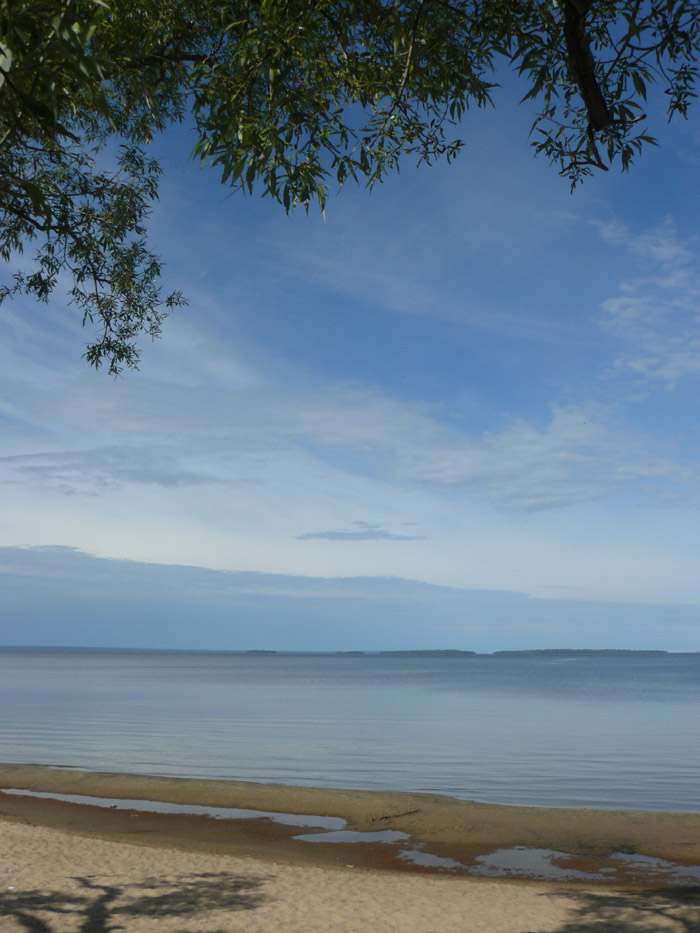 Location Taken: Shore of Lake Nipissing, in North Bay, Ontario
Location Taken: Shore of Lake Nipissing, in North Bay, Ontario
Time Taken: June 2010
North Bay’s loveliest feature has to be the large lake right next to it, Lake Nipissing. My family stopped there overnight on our cross-countries trip that I mentioned last Saturday, in my very first post. Before heading to a local hotel, we drove along the shoreline to enjoy the lake, stopping and taking photos occasionally.
This particular photo looks out across the lake towards the Manitou Islands. Now, Manitou is a fairly common name for islands in the Great Lakes region, with these islands in Canada, two in Lake Superior, two in Lake Michigan, and, according to the disambiguation page on the subject on Wikipedia, possibly also a lake in Minnesota. Possibly. The link to that one’s currently red, and looking at the lake in Google Maps doesn’t even show a name for the island. And there isn’t even a link to the Manitou Islands I’m talking about. Hmm. If I was inclined to edit Wikipedia, I would fix that…
There is something rather interesting on the actual Wikipedia page for the actual Manitou Islands I’m talking about. Apparently, these islands, as well as a local bay, are old, eroded volcanic pipes!
I know, most of you are going “Whuh? Does that mean they’re going to explode or something?” while a few of you are like me and are going “Nifty! Are they kimberlite pipes?”
Alas, no, they are neither likely to explode nor are they kimberlite.
…Perhaps I should explain more.
Volcanic pipes form from the deepest volcanoes on earth, originating up to several hundred miles/kilometers underground, well inside the mantle, and only in areas of high pressure and temperature found below the thickest rocks of Earth’s crust. They tend to erupt only the once, but they erupt rather violently, bringing up material from deep below to the surface without giving the rock inside a chance to metamorphize on the way up. They’re one of our best ways to figure out what makes up most of this floating ball of mostly-molten rock we live on. There are a few rocks that are only found in volcanic pipes, such as kimberlite and its much more famous inclusion, diamonds.
Normally, when diamonds work their way up to the surface from deep below, they metamorphize to graphite on the way. For all their hardness, diamonds are fairly fragile stones, which is why we can actually cut them into gems. They’re certainly not forever, since given enough time in the pressures found at the surface, they will eventually turn into graphite. Don’t worry about your jewelry, though, I’m talking geologic time here, and they’ve got some natural crystal stability to them as well. Just don’t heat them to 700°C. That will definitely start them turning to graphite.
If you want a stone that will last forever, go for zircons. No, not cubic zirconia, that’s zirconium dioxide, I’m talking about zirconium silicate here. The oldest rocks found are all zircons, dating back all the way to 4.0 to 4.4 billion years ago. The earth’s only estimated at 4.6 billion years or so, so that’s an awfully long time for these rocks to still be hanging around in their original form. So if you really want to show the length of your love, get her a zircon ring. Sure, it’s not a pretty stone, sure, most people will think you’re talking about cubic zirconia and that you’re cheap, and sure, any advantage it has over diamond won’t matter for millions of years, but it certainly can outlast all those sparkly diamond posers!
